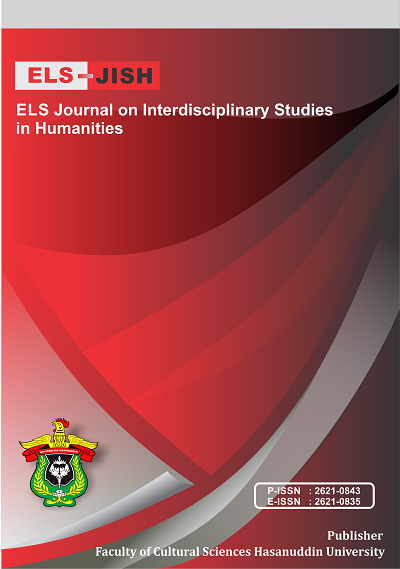Meaning and Use of Haiku in the Game “Bungou to Alchemist”
DOI:
https://doi.org/10.34050/elsjish.v5i3.23170Keywords:
Haiku, Roland Barthes Semiotic Theory, Bungou to Alchemist, Kawahigashi HekigotouAbstract
Haiku is a Japanese poem that is unique and uses a minimum of words, but it is still beautiful and has deep meaning. In this modern era, there are educational games that use haiku. One of them is the Japanese literary-themed game 'Bungou to Alchemist'. This game is about poets who are brought to life by alchemists to protect endangered Japanese literary works and eradicate the enemy, namely shinshokusha. Alchemist plays the role of librarian (shisho), who directs the bungou (poet) to eradicate the shinshokusha. One of them is Kawahigashi Hekigotou, a famous Japanese haiku poet. The aim of this study is to find the meaning contained in Hekigotou's four haiku that appear in the game and to identify the cause of the four haiku being used, using Roland Barthes' semiotic theory. This study used qualitative research methods. The result of the analysis is to show that Hekigotou's haiku used in this game has meaning related to life and is used to strengthen the conveying of Bungou to Alchemist ideas contained in the haiku in the form of a representation of Kawahigashi Hekigotou's feelings. At the same time, this game is a place for young people to get to know and learn literature, especially haiku.
References
Aminuddin. (2009). Pengantar Apresiasi Puisi Karya Sastra. Bandung: Sinar Baru Algensindo
Andini, C., Sosrohadi, S., Fairuz, Dalyan, M., Rahman, F. F., & Hasnia, H. (2022). The Study of Japanese Women in the Facial Treatment Advertisement: A Semiotics Perspective of Pierce’s Theory. ELS Journal on Interdisciplinary Studies in Humanities, 5(2), 337-347.
Anriadi, Rahman, F. & Pattu, M. A. (2021). The Practice of Symbolic Violence in George Orwell’s Novel 1984. American Journal of Humanities and Social Sciences Research (AJHSSR), 5(11), 144-153
Barthes, R. (1967). The structuralist activity. MA ENGLISH, 19. School of DistanceEducation Calicut UniversityP.O.
Color image, Retrieved on August (https://iro-color.com/episode/about-color/yellow.html)
Creswell, J. W. (2010). Research Design Pendekatan Kualitatif, Kuantitatif, dan Mixed. Yogyakarta: Pustaka Pelajar .
Fairuz, F. (2021). Metaphor on Japanese song Lyric By Miwa: AStylistic Study. Journal Of Cultura and lingua, 2(1), 26
Fairuz, Rahman, F., & Amin, M. A. (2022). Authors’ Figurative Expressions From Two Novels: A Comparative Analysis Between RTJNA Rosso and RTJNA Blu. Theory and Practice in Language Studies, 12(1), 150-157.
Fujisan, Retrieved on July 2022, https://www.mtfuji.or.jp/knowledge/cultural_values
Games, D. (2017). Bungou to Alchemist Official Character Book. Tokyo: Ichijinsha.
Isoji, A. S. N. (1983). Sejarah Kesusastraan Jepang. Jakarta: Universitas Indonesia UI Press.
Jariah, R. A., Rahman, F., & Pattu, M. A. (2022). Social Problems In Drama 13 Reasons Why: Peirce Semiotics Approach. TEKSTUAL, 20(1), 48-60.
Love green, Retrieved on August (https://lovegreen.net/languageofflower/p22818/).
Rahman, F. (2022). Instruments of Symbolic Violence in George Orwell’s Animal Farm. Journal of Language Teaching and Research, 13(4), 826-833.
Rahman, F., & Weda, S. (2019). Linguistic deviation and the rhetoric figures in Shakespeare’s selected plays. XLinguage" European Scientific Language Journal", 12(1), 37-52.
Saskia, A. F. (2020). Mitos Sake Dalam 3 Lirik Lagu Enka Hibari Misora. AKSARABACA Jurnal Bahasa, Sastra, dan Budaya, 1(1).
Sobur, A. (2017). Semiotika Komunikasi. Bandung: PT Remaja Rosdakarya.
Sudibyo, A. (2001). Politik media dan pertarungan wacana. LKIS PELANGI AKSARA.
The Dictionary of the Language of Flowers TOP, Retrieved on August, (http://www.hanakotoba.name/archives/2005/09/post_114.html).
昼寝(ひるね) 三夏Retrieved on July 2022, http://kigosai.sub.jp/kigo500a/307.html
お探しのページが見つかりませんでした,Retrieved on July 2022, http://kigosai.sub.jp/kigo500a/307.html (diakses pada 18 September 2020).
Downloads
Published
Issue
Section
License
Copyright (c) 2022 Fairuz Fairuz, Indah Mutiara, Fadhilah Fadhilah

This work is licensed under a Creative Commons Attribution-NonCommercial-ShareAlike 4.0 International License.






